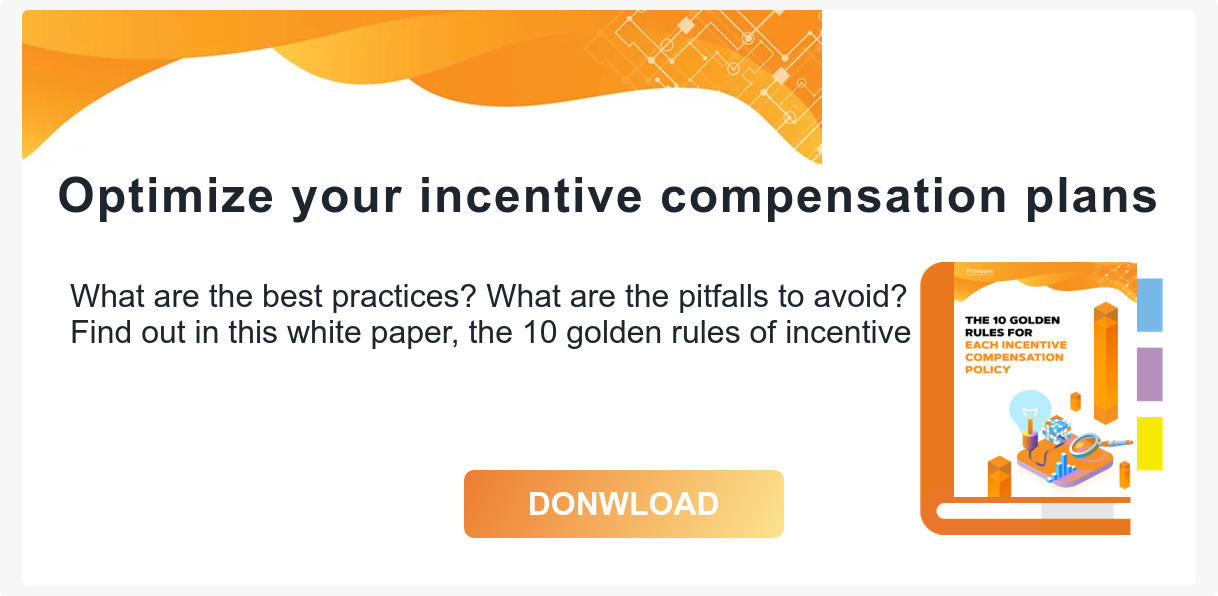Commission based pay is appreciated by many employers who want to propose a variable portion of employee salaries that is directly linked to the company’s financial objectives. How does commission based pay work, what are its advantages and limits and what commission scheme is best for your company and employee profiles? Here’s a detailed look at the oldest form of incentive compensation.
What is a commission based pay scheme?
Commission based pay is a form of incentive compensation which involves paying an employee on commission, based on the income directly generated for the company by the employee. Commissions are usually calculated as a percentage of turnover, the number of sales or the gross profit generated by the company. Depending on the company, the commission based pay scheme can be fixed or variable, with minimum and/or maximum amounts.
Progressive rates
Some businesses go for progressive rates to boost their global sales. In other words, the higher the turnover, the more commission the employee receives. This commission based pay scheme requires extremely detailed company finance management such that the employee incentive compensation is increased significantly and sustainably.
Capped commission
The employer can also decide to cap the commission by defining stages to be reached. At each stage, the employee receives commission as a pre-defined fixed amount. The point of this type of commission based pay scheme is to incite the employee to favour a qualitative approach without over-performing and thus generating an excessive variable part to their salary. This type of commission based pay scheme therefore involves a maximum amount which cannot be exceeded.
Tiered commission
This type of commission based pay involves a compensation amount that is paid to the employee according to the objective met. The aim of this method is to boost employee motivation by proposing rates that increase as they pass the various tiers. However the employee can always decide to stick to a specific tier and not seek to reach the next one.
What kind of employee is suited to commission based pay?
Commission based pay is generally applied to sales representatives and teams directly involved in the company’s sales force. Employees who do not directly contribute to the company’s financial income are more rarely concerned by this kind of incentive compensation.
And commission based pay is a wage structure much liked by new business in need of immediate and significant results to win over a market. Long-standing businesses that are no longer operating with a market sector domination strategy tend to go for other forms of incentive compensation, such as objective indexed bonuses.
How is the commission amount calculated?
Calculating the commission amount is generally quite simple. Businesses start by defining the financial elements on which the commission can be based. This could be turnover, the number of products or services sold or the company’s general net profit. Then the employer selects the commission rate they want to pay to the employee. For example, this could be 3% of the turnover generated or 5% of total sales for a given period.
Why go for commission based pay?
Adopting commission based pay is a way to significantly increase the motivation of sales staff by allowing them to generate a sizeable and potentially progressive incentive compensation portion. Additionally, commission based pay is very closely related to the company’s income, this form of incentive compensation directly associates the employees in question with the company’s global strategy and economic priorities.
Low sales and turnover generally means that the commission rate is low. However, if the sales team generate high financial income then the commission amounts can be higher. In this way sales teams will be incited to achieve the company’s general objectives in order to ensure that the incentive compensation part of their wages reaches their individual expectations.
The limits of commission based pay
In spite of a significant impact on employee motivation, commission based pay does have its limits. In fact this form of incentive compensation cannot involve the expression of a performance requirement and thus may limit company performance to the ambition of its sales team. This type of calculation is particularly suited to entrepreneuring profiles which are both hard to find and rather hard to manage. This is why a lot of businesses prefer to reward the performance of their employees through objective indexed bonuses.
Commission cap lifting
Capping a commission involves setting a maximum amount that the employee may receive as commission, even if they exceed their objectives. This kind of commission based pay scheme may be preferred by a certain number of businesses but is not the most popular. A lot of other employers feel that it might be better to reward exceptional performance at its true value.
Lifting commission caps, is not only easy to set up it is also easy to justify since most businesses that apply commission based pay propose a lower average basic pay than the others (up to 70% of the global compensation instead of 75% for other businesses in general). And a lot of employers feel that not applying commission caps is fairer, the variable part of the wage comes to represent a major part of the total pay, and sales staff therefore need to prioritise their contribution to the company’s global income.
What’s more, combining commission cap lifting with a trigger threshold, rather than applying commission from the first euro earned will contribute to healthier sales team motivation. In fact the failure to apply a threshold could see the commission based pay becoming an automatic income that is simply the result of the sales representative having a portfolio of regular customers.
The choice between commission based pay and objective indexed bonuses
Objective indexed bonuses have the advantage of using both quantitative and qualitative indicators to measure employee performance. In addition to the number of sales and the turnover generated, other parameters come into play such as the prospecting of new customers, conversion rate or customer satisfaction.
Objective indexed bonuses must therefore use quality and quantity indicators that can be evaluated simply and clearly. And furthermore, businesses that wish to evaluate the qualitative nature of commercial relations for sales that also involve non-sales teams will more naturally turn towards an objective indexed system.
As a system that directly rewards employee performance, objective indexed bonuses are freed of the limits affecting commission based pay schemes since they are based on the attribution of an amount related to the achievement of a fixed objective along with a maximum bonus in the event that the objective is exceeded, this therefore allows a performance requirement to be associated with the bonus to be paid out.
However, to be effective, the objectives will need to be realistic but not too low. They must cover the various motivation levers and be an integral part of the company’s global strategy. Objective indexed bonus schemes may seem more complex to set up than commission based pay schemes to some employers, who will therefore turn towards commission-based schemes.
It is also possible to combine the two systems by proposing a commission rate indexed to turnover in addition to objective indexed bonuses based on different performance cycles specially set up to suit specific sales missions.
Presenting your commission based pay scheme effectively
Once the decision has been made to apply a commission based scheme, and the type of plan has been selected, it will be important to present it effectively to the staff concerned. For the dialogue to be calm and harmonious, it must remind employees how important their contributions to the company really are. This is the ideal time to take a look at the various missions and highlight the benefits of commission based pay for the company as well as for their salaries. A clear, simple and legible compensation scheme presentation will allow employees to get a better understanding of their professional impact on the company.
The commission-based pay scheme must be the subject of regular exchanges with the sales team such that the pertinence of its specifications can be verified in terms of the company’s changing needs and employee expectations. To be successful, the commission-based pay scheme must be adapted to suit each cycle and be adjusted where necessary to suit any changes in the business’ financial and strategic development and employee missions.
5 sales commission-based pay models
There can be different possible sales commission-based pay models depending on the company’s size, maturity and business sector.
1. Commission associated with the basic pay
This model is not only the most popular but it also allows the employer to propose a relatively low basic pay in the hope that the sales team will be motivated to achieve high objectives in order to stimulate their overall income. The sales team will be less inclined to leave the company and will therefore have the opportunity to manage a customer portfolio over the long term. The company must however take care in their choice of commission-based pay scheme such that it remains motivating and coherent with the company’s global objectives.
2. Commission based on gross profit
Rather than proposing a commission on each sale completed, this scheme involves paying a commission on the company’s net profit for each sale. This system involves a more detailed company treasury management and pushes sales teams to prioritise high value sales. However, such a high incitement to concentrate on bigger sales and base the commission amount on gross profit could discourage sales teams from being flexible with potential customers, therefore potentially reducing the number of sales made.
3. Specific commissions
Instead of proposing a commission calculated from the first euro that the sales operative earns for the company, this model rewards only specific sales, or a pre-defined number of sales. So instead of paying out a percentage of the turnover generated by the sales, the company only rewards the larger objectives when they are reached. This model is easy to calculate and has the advantage of being especially motivating for sales teams. In spite of all of this it does present the risk of demotivation should the objective be too difficult to reach and this could also mean that the company might miss out on major opportunities.
4. Phased commissions
Quite contrary to specific objective commissions, this scheme requires the definition of tiers. Instead of receiving a bonus when the objective is reached, employees receive a percentage of all sales completed until the next tier is reached. This percentage is often progressive and increases as each tier is reached. This scheme is more inciting and encourages sales teams to increase their efforts to reach the different objectives set for them by the company. This model is more complex to implement and obliges the company to be able to significantly increase employee commission rates.
5. Commission with no basic pay
This model is very rare and involves only paying sales representatives in the form of commissions paid out as and when sales are completed. It is evidently most often proposed to sales agents. The employees or agents therefore have total control over their income and are implicitly incited to make a maximum number of sales. However, the absence of a basic pay can be a major complication for recruitment and considerably increases the risk of a high staff turnover. And a model that is exclusively based on quantity and thoroughly neglects quality can be dangerous for the company image.
To be truly effective, commission-based pay must be motivating for staff and fully aligned with the company’s strategic pillars. The choice of commission-based pay requires flexibility to find the best suited model for the company’s sales teams. Making adjustments over time is also absolutely necessary for this type of incentive compensation to remain attractive and beneficial.




